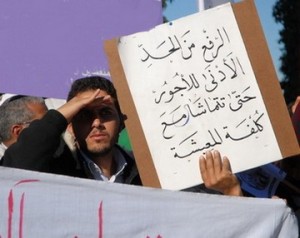
 2019-07-29
2019-07-29
To address poverty and the increase of prices, "Tamkeen" calls for raising the minimum wage
In a recently published position paper, Tamkeen for Legal Aid and Human Rights recommended that the minimum wage be raised to ease the burden of the people due to current economic conditions in the Kingdom and the constant increase in inflation rates. The organisation also called for the inclusion of migrant workers and refugees within the minimum wage decisions.
Furthermore, Tamkeen called on the committee to work on upholding the 8th article of its latest decision in 2017 which calls for the yearly review of the minimum wage according to the economic and social conditions including: cost of living, economic status, and GDP. It also iterated the need to face any recurring challenges that hinder the process of implementing the minimum wage decision on all workers in the various sectors in the labour market. Such steps would contribute to addressing any legislative obstacles in organizing the relationship between employers and workers; as well as contribute in better economic development and the protection of all parties involved in the productive process.
The position paper pointed out that “the increase that occurred in the minimum wage was gradual. Thus, in the years preceding to the Global Financial Crisis in 2008, increases to the minimum wage were slight as they ranged between 5-10 JOD. These small raises were due to the stability of the Jordanian economy; as economic growth rates were high and GDP ranged from 5.1% to 7.3% between 2000 and 2008, and prices remained within stable ranges.”
However, the situation began to change following the Global Crisis, as the Jordanian economy, like its global counterpart, began suffering as a result of many variables. As a result, Jordan’s economic growth began a gradual decline until it reached 1.9% in 2018. Subsequently, inflation rates began increasing; resulting in successive increases in the minimum wage ending in the 2017 decision which raised it to 220 JOD.
Despite these raises, the position paper posed a question of “whether the current amount is adequate to meet the levels of living standards as prices continue with their hikes affecting workers’ ability to provide for the basic commodities that they and their families need”.
The paper then moved to talk about factors related to the Minimum Wage. The first of which is the inflation rate where the paper made clear that the increase that occurred in recent years was due to several external factors. While these factors included external ones that included wars in the region and the continuing waves of asylum; they were also due to “economic factors as the country changed its economic policies by removing subsidies on oil derivatives as well as other products including bread. Consequently, the Consumer Price Index (Inflation) hit a new record high, increasing by 0.5% on an annual basis in June 2019.”
According to data released by the Department of Statistics, the increase was due to the increases in rents; the prices of meat and poultry, vegetables, dried and canned beans, grains and education.
The high rate of inflation is due to several reasons. They include: increased taxes, reduced purchasing power of consumers; in addition to rising fuel prices. Subsequently, other products prices began increasing including essential goods like: vegetables, fruits, canned goods, among others. Additionally, the government began subjecting taxes on commodities that were previously exempt to taxes that ranged between 4% and 5%, while subjecting 164 other commodities to 10% tax as well. The government said it has taken these steps in an effort to increase government revenues by about half a billion JOD to reduce the deficit the general budget.
Other increases followed as the government also raised public transport fares by 10%; the prices of bread by 100% following the lift of the subsidy; and the prices of Octane Gas, in its two ratings: 90 and 95 by 6%.
While these prices were rising, the minimum wage remained as it was set in 2017 at 220 JOD. In fact, the figures by the Social Security Corporation show that there are 113,000 Jordanian subscribers under that umbrella whose wage is 220 JODs. The same records show that 79 thousand non- Jordanians workers receive wages that are equal to or less than the minimum wage. Of course, these figures do not include the multitudes of workers who are unregistered either due to the refusal of their employer or due to their work in the informal sector.
The paper mentioned that the above-mentioned highlight why a raise to the minimum wage is needed, particularly the increase in inflation rates in the period between 2012-2019; as well as the increase in the unemployment rate. In fact, the latest governmental numbers indicate that the unemployment rate in the first quarter of 2019 (19%) is an increase by 6.0 percentage points from the first quarter of 2018. The rate has reached 4.16% among males, while it was 9.28% among females.
It was also highlighted that while there are many reasons behind the decline in economic participation, the low wages rate is considered an important one. Consumer Price Index (CPI) also recorded increases in all recorded categories as it recorded 124.66 points in 2018 compared to 119.23 points in 2017 and 115.49 points in 2016.
The linkage between the minimum wage and inflation according to the paper is quite clear as the raise in the wage would boost the purchasing power for workers, since there is an inverse relationship between purchasing power on the one hand and inflation on the other. As such, in cases of higher prices while wages maintained the same levels, purchasing power would drop. On the other hand, when wages rise at a consistent or even higher rate compared to prices then the purchasing power is improved.
As for the poverty line, the paper said that while the Jordanian Labor Law links the amount of minimum wage to the cost of living; there is a major obstacle in regards to identifying these standards due to the controversy over the poverty line. Thus, while international standards stipulate that the minimum wage must be higher than the poverty line level as it is considered as the red line that cannot be crossed, it is difficult to follow this rule when the line is unknown.
While the previous absolute poverty rate as published in the government stood at 14.4% as of 2010, which was an increase from 13.3% in 2008; the new reports indicate that it has yet again increased to hit 15.7%. The new rate was first announced by the Prime Minister and then later confirmed by the Department of Statistics in their annual report, though the report did not clarify whether this rate is for absolute poverty or extreme poverty. The report did have other related information as it stated that the poverty gap reached 3.5%, while the poverty severity hit 0.334%.
These rates mean that the absolute poverty line is now higher than 100 JOD per individual per month. It also means that the extent of poverty has widened in the last 8 years as it rose from 14.4% in 2010 to 15.7% in 2018. As a result, the poverty line rises from 68 JOD per person per month (816 JOD yearly) to 105.6 JOD (1226 JOD yearly).
As for families, the new ratio means that a family can be classified as poor if its monthly expenditure is less than 528 JOD; considering that it is composed of five individuals, which is the standard family size in the Kingdom.
Thus, in such a situation a family where two people out of five members are employed and both earn a salary set at the minimum wage of 220 JOD, are now considered under the poverty line as their monthly expenditure would definitely be below the poverty line set at 528 JOD per month. While the above hypothesis might be difficult to believe, figures from Social Security indicate that this the reality for 56% of Jordanians based on the salaries that they receive.
The paper ended on a grim reality as based on the new rate, Jordan could be considered one of the 10 poorest countries in the world. The claim is based on the latest statistics published in this regard by the World Bank. According to the report, the 10 poorest countries have a poverty rate set between 86.9% which is the highest and is in Nigeria and 14.2% in Uganda. As such, with a rate of 15.7% Jordan is one of the 10 poorest countries in the world.

